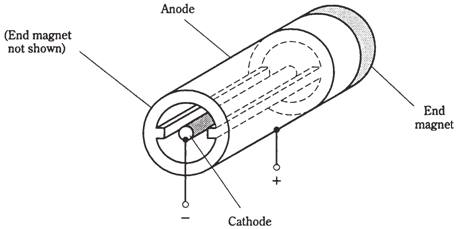The magnetron
Most magnetrons contain the cathode at the center, and a surrounding plate as shown in the figure given below. The plate can be divided into cavities, by radial barriers. The output is taken from opening in plate and passes into a hollow waveguide which serves as a transmission line for UHF or microwave energy.
The cathode is connected to negative terminal of a high voltage source, and anode is connected to positive terminal. Thus, electrons flow radically outward. A magnetic field can be applied lengthwise through the cavities. As a result of which, the electrons move outward in spirals from cathode to anode, rather than being in straight lines.
The electric field produced by high voltage, interacting with longitudinal magnetic field and the effects of cavities, causes the electrons to bunch up into clouds. The swirling movement of electron clouds generates the fluctuating current in anode.

Figure--A magnetron. Here, only 2 cavities are shown for clarity; often there are several cavities.
This is UHF or microwave signal. The frequency depends on the shape and size of the cavities within magnetron. Small cavities result in highest oscillation frequencies; larger cavities produce oscillation at the relatively lower frequencies.A magnetron generates more than 1 kW of RF power at the frequency of 1 GHz. As frequency increases, realizable power output decreases. At 10 GHz, a characteristic magnetron generates around 20 W of RF power output.
Magnetrons can generate microwaves for use in cooking. The energy at these specific frequencies excites the molecules in the organic substances like vegetables, meat, and grains. The microwave oven uses a magnetron rated at around 500 W to 1 kW continuous output power.